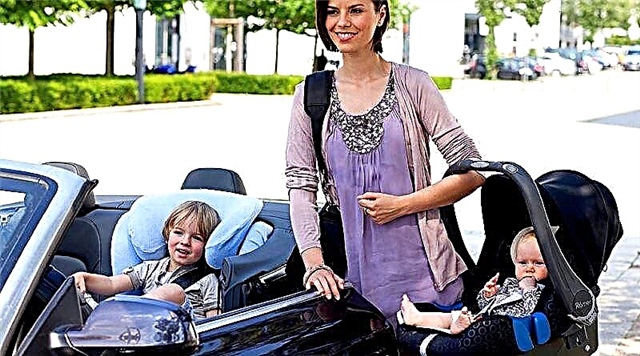 For the first four months, the baby ate exclusively breast milk or formula. The time has come for the first feeding, since by the fifth or sixth month the baby will not have enough milk nutrients for full growth. By the first half of the year, the mucous membrane of the baby's neck can already adapt to swallowing solid food particles.
For the first four months, the baby ate exclusively breast milk or formula. The time has come for the first feeding, since by the fifth or sixth month the baby will not have enough milk nutrients for full growth. By the first half of the year, the mucous membrane of the baby's neck can already adapt to swallowing solid food particles.
It is worth introducing the first complementary food for a child only when he gains weight twice as much as at birth and will sit steadily. The baby must have a so-called "food interest", he must be interested in the food consumed by the rest of the family.
We accustom your baby to new food
It is better to start feeding a child with vegetable puree. It has all the necessary benefits for a new infant nutrition:
- A varied composition of mineral salts necessary for the growing skeleton of a baby.
- A large number of vitamins and biostimulants.
- Vegetable fiber, which regulates bowel function.
- The content of alkaline salts is necessary for a good metabolism, improving breathing, toning up the nervous system and removing excess water.
- The lack of sweetness will help the baby better perceive the second complementary food - porridge.
- Keeping dense lumps in the puree will prepare the throat for swallowing solid food.
It is necessary to accustom the child to complementary foods gradually. Start with a spoon or two before your second or third breastfeeding. In addition to vegetables, you can add half the yolk and a little vegetable oil to the puree. For a month, the amount of puree is brought to 150 g (three quarters of a glass) and one breastfeeding is completely replaced. You can also divide complementary foods into several receptions. It is important for the baby to enjoy the meal.
Nutritional innovations often do not go smoothly, sometimes the child does not want to eat complementary foods. Of course, not all children eagerly join new food. The taste buds in babies are well developed and from the very birth they get used to the sweetish taste of milk. It is important to immediately establish contact with the baby in relation to food, otherwise further feedings will turn into torture on both sides.
What to do if a child refuses to eat complementary foods
So, the first and second attempts to feed the baby failed.The child does not want to eat complementary foods and what to do if he spits out food or even starts to vomit.
- First, you should not be afraid of gag reflexes. At this time, they have a functional origin. Most often, vomiting occurs when the period of breastfeeding is prolonged.
- Secondly, the desires and tastes of the baby must be reckoned with, but still kindly insist on their own. Taste can be developed not by coercion, but by the use of little pedagogical tricks.
[sc: rsa]
Here are some practical tips if your baby is reluctant to eat complementary foods:
- give a new type of food on an empty stomach;
- observe the diet - the baby must want to eat;
- first sweeten the puree with breast milk or formula a little;
- find out the baby's taste preferences: some children eat mashed potatoes better, others from Brussels sprouts, and for the third, serve a mix of different vegetables;
- if the baby does not like the new dish, do not insist, try offering another dish, and return to this in ten days;
- introduce new products gradually, feed one kind of puree for a week and then try a new one;
- sit your baby at the table during a family meal, show and tell how you enjoy eating. Give him a few grains from your plate, let him try;
- the most important thing is no violence, it is not scary, if once the child remains hungry, let it be better to eat a little, but with pleasure;
It happens simply, the child does not feel well: teething or tummy hurts, so he refuses to eat complementary foods.
Don't distract your baby with toys or try to feed them discreetly. In the first case, the formation of the wrong habit of eating while playing will begin. Invisible feeding will not bring any benefit to a small body. When the baby does not want to eat, the salivation in the mouth and the production of gastric juice are reduced, and the food is poorly digested.
An excellent way to accustom your baby to new food is the pedagogical feeding method. The child is simply seated at a common table and allowed to taste whatever he wants in miniscule amounts: a pea-sized piece or a sip of liquid.
Doesn't want to eat from a spoon
 You need to start feeding your baby solid food using a spoon. It is good if it is a silver product (silver prevents the development of microbes), but a spoonful of plastic will do (plastic spoons are safe for a child, and thanks to bright colors, they attract attention, so the baby will be happy to eat from it).
You need to start feeding your baby solid food using a spoon. It is good if it is a silver product (silver prevents the development of microbes), but a spoonful of plastic will do (plastic spoons are safe for a child, and thanks to bright colors, they attract attention, so the baby will be happy to eat from it).
In terms of size, it is better to take a coffee shop first, then go to a tea house.
The sooner the baby gets to know the cutlery, the fewer problems with complementary foods will arise. It is advisable to drink water from the third month only from a spoon. If the child does not want to eat complementary foods from a spoon, then during training to a spoon, you should not feed him from the nipple, it is better to let the baby first take the food with his hands, let him try to eat himself. Then give a spoon. The child and everything around will be smeared, but it is much easier to clean everything than to suffer further. Gradually, the baby will get used to the spoon and will be great to eat from it.
We read the article:How to teach a child to eat with a spoon
See video:
Doesn't want to eat porridge
A small family member begins to give porridge from 6 to 7 months. First, one teaspoon of buckwheat, rice or corn. Gradually, the volume of complementary foods increases to 150 g, and the range of cereals is expanding. It is necessary to cook porridge for a six-month-old baby in water or a decoction of vegetables, without adding milk and sugar.

As with vegetable puree, it happens that the child does not want to eat porridge. In this case, you should also cheat a little. Add some breast milk to the finished dish. The taste will become more familiar to the baby, which will allow him to quickly get used to the new diet.
Complementary feeding is not always a substitute for breastfeeding, but only a necessary addition to the baby's nutrition. It's like getting to know "adult" food. It's okay if the child flatly refuses mashed potatoes and porridge. Be patient. Watch the baby, because in this case he is the most important advisor.
On the topic of complementary foods:
- Introduce: Complementary feeding on GW;
- Introduce: Prikom on IV.



